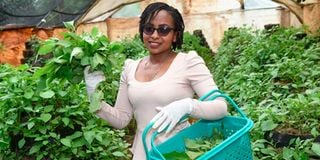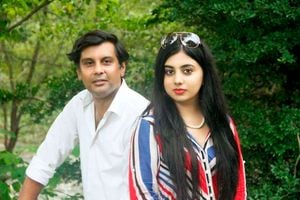Why you should consider planting traditional seeds

Ms Mutile Wambua, 34, harvests nightshade vegetables (managu) at her farm in Yamumbi, Uasin Gishu County.
What you need to know:
- Kenyans are losing some varieties of their traditional foods and seeds.
- Narrowing the diversity of vegetables on our plates to only three types of vegetables leaves the remaining indigenous species to be ranked in the category of neglected species.
Traditional food experts in the country urge Kenyans to embrace indigenous foods and preserve them for future generations to promote healthier lifestyles.
Speaking at the second edition of the Indigenous Seeds and Food culture Harvest Fair held at the National Museums of Kenya, Patrick Maundu, a researcher in the field of traditional foods and ethno botany, said Kenyans are losing some varieties of their traditional foods and seeds.
“I have been monitoring how much we have been losing in terms of biodiversity. If I look at the diversity we have, in terms of vegetables for instance, over the years we have documented more than 220 species of vegetables across the country. As time goes by, we have been neglecting the traditional vegetables, mainly going for cabbage, sukuma wiki or spinach,” he said.
Mr Maundu told Healthy Nation that narrowing the diversity of vegetables on our plates to only three types of vegetables leaves the remaining indigenous species to be ranked in the category of neglected species.
“We have been carrying out research on the neglected species and we found out that they are useful, nutritious and that they adapt to our local environment. They also need less input compared to what we are going for,” he explained.
He said that the country has not lost so many vegetable species, but it is the variety that is fading away.
“Some of these vegetables are indigenous to the country, others may have been introduced in the past. Cow peas (kunde) for instance, is an indigenous vegetable. Because it has been cultivated for many years, it is so varied. People came up with different varieties that suit their needs. These are slowly fading away,” he explained
Anne Maina, the national coordinator for the Biodiversity and Biosafety Association of Kenya and chairperson of this year’s seed fair committee, said the government should put more effort in preserving and promoting super foods like the finger millet, sorghum, cassava, among others.
“If we put more effort in promoting these crops, Kenya will no longer be a food importer and we will be food secure. A few years ago, Kenya was able to feed itself, but now we are importing most of our foods including maize, wheat and rice,” she said.
“We are working on developing a national agroecology strategy so that we can bring on board different sustainable food practices in our country. We want farmers to reduce the use and abuse of toxic pesticides,” she added
Farmers and experts at the event also decried the law that prohibits them from exchanging seeds. They said that the Seeds and Plants Varieties Act (2012) makes it difficult for them to get other seeds or even share with others those that they have.
“We raised those issues sometime last year and now the Ministry of Agriculture is taking a review of the seed laws. Our only issue as civil society is that this process has been quite limiting. There hasn’t been a lot of investment from the civil societies,” said Anne.
While exhibiting different traditional seed varieties in the country, Samuel Nderitu, a farmer and director of Grow Biointensive Agriculture Center of Kenya, said in the wake of climate change, indigenous seeds are more resilient to its impacts compared to the hybrid ones.
“Indigenous seeds can withstand both the rains and drought. They are also not likely to be affected by pests and diseases. Such crops are also not likely to be feasted on by the birds,” he said
Nyamongo Desterio, a researcher at the Kenya Agricultural and Livestock Research Organization (KALRO) gave context to an example of an indigenous maize –the coloured maize- that some farmers ditched for the all-white hybrid maize.
“The colour that you see is because of the micronutrients that the maize has…they have antioxidants. These are chemicals that remove heavy metals in the body and make you continue looking young. The oxidants, on the contrary, makes you age faster,” he explained.
He noted that in the wake of climate4 change, farmers have realised that the high-yield crops are not climate resilient and are slowly going back to their roots.
“If the season is bad, let’s say there isn’t enough rainfall, the yields will not be high. People are going back to the indigenous maize because they are early maturing and resistant to droughts,” he added.
Dr Felister Makini, KALRO’s deputy director general Crops, added that scientists need to do more in regards to documenting the different varieties of crops that are in the country.
“People are becoming more nutritiously conscious, that is why we have to keep these crops. We need to sensitise the youth who only know about the exotic crops,” he said.





